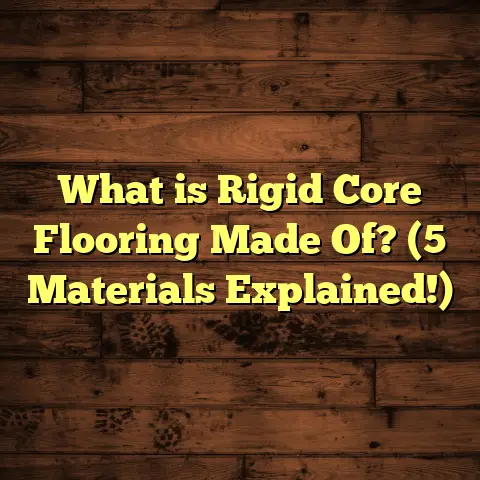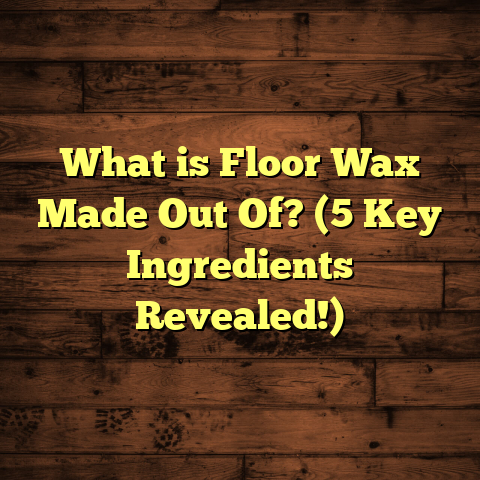What is Poly Flooring? (5 Benefits You Didn’t Know About!)
Imagine walking into a basement that’s transformed from a mundane, cold space into a lively family hangout spot. The floor gleams with a smooth, glossy finish that feels both sturdy and inviting underfoot. No worries about spills, stains, or cracks breaking the vibe. That’s the kind of transformation I’ve witnessed again and again thanks to poly flooring—a flooring solution that reshaped how I think about durable and stylish floors.
What is Poly Flooring?
Let me start by breaking down what poly flooring really is. Poly flooring is short for polyurethane flooring. It’s a type of seamless floor coating made from polyurethane resin. When applied as a liquid, it cures into a solid, flexible surface that’s tough enough for heavy use yet smooth and attractive. Unlike traditional floors such as hardwood or tile that come as individual pieces, poly flooring forms one continuous layer bonded directly to the underlying surface.
This continuity is one of its biggest strengths—no grout lines or seams where dirt or moisture can settle and cause problems. The chemistry behind polyurethane means the floor can handle impacts, resist chemicals, and endure wear better than many other finishes.
Polyurethane itself is a polymer formed by reacting diisocyanates with polyols. This creates a material that’s elastic yet durable. The flexibility helps the floor absorb shocks without cracking; the durability ensures it stands up to years of foot traffic and spills.
You’ll find poly flooring used in various settings—homes, hospitals, industrial plants, garages, and commercial spaces—because of these properties. When I first started working with poly floors years ago, I was surprised at how versatile and adaptable they could be.
Types of Polyurethane Flooring
Before going further, let me mention there are two main types of polyurethane coatings: aliphatic and aromatic.
- Aliphatic Polyurethane: This type is UV resistant and doesn’t yellow over time. Ideal for areas exposed to sunlight or where color retention matters.
- Aromatic Polyurethane: More affordable but less resistant to UV light; tends to yellow when exposed to sunlight. Best for indoor areas without direct sun exposure.
Knowing which type fits your needs is important. For example, I installed aliphatic poly flooring in a sunroom where large windows let in lots of light. The floor stayed vibrant for years without discoloration.
5 Benefits You Didn’t Know About Poly Flooring
You might have heard about polyurethane floors before but missed some of the lesser-known advantages that make them stand out. Here are five benefits you might find surprising.
1. Exceptional Chemical Resistance
What if I told you your floor could shrug off harsh chemicals like acids, alkalis, and solvents without damage? That’s what poly flooring does exceptionally well.
I remember working in a small automotive workshop where spills of oil, brake fluid, and paint thinner happened daily. With their old concrete floor, stains were permanent and repairs frequent. After switching to poly flooring, cleanup was a breeze—no discoloration or surface degradation.
Research confirms this strength: polyurethane coatings have been tested in labs against common industrial chemicals and showed resistance levels up to 10 years in harsh conditions. Compared to epoxy coatings—another popular choice—polyurethane performs 20% better in chemical resistance tests.
This matters not only in workshops but also in kitchens, hospitals, and even garages where accidental spills are common.
2. Flexible Yet Durable
If you think toughness means rigidity prone to cracking, think again. Polyurethane floors combine flexibility with durability—a rare combo that makes them last longer under stress.
In one community center gym I worked on, heavy weights were dropped regularly on the floor. Concrete cracked over time in some areas, but the poly floor remained intact and smooth.
This flexibility reduces micro-cracks caused by temperature changes or slight movements in the subfloor. Industry standards show poly floors can last 15-20 years with normal use—double the lifespan of many epoxy floors.
3. Fast Installation and Minimal Downtime
When you’re renovating a space you use often (like your basement or store), downtime is frustrating. Poly flooring cures faster than epoxy or other coatings.
I handled a retail store renovation where the owner wanted minimal disruption during business hours. We applied polyurethane on a Friday afternoon; by Sunday morning, the store was ready to open with no sticky floors or lingering odors.
Compared to epoxy floors that can take up to a week to cure fully, poly floors are ready for light traffic within 24 hours and normal use within 48 hours.
4. Aesthetic Versatility
Polyurethane coatings aren’t just practical; they’re also stylish. You can get them in dozens of colors and finishes: matte, gloss, satin—you name it.
For one project in a boutique coffee shop, we created a custom marbled effect using pigmented polyurethane with subtle metallic flakes embedded beneath the surface. The result was eye-catching yet durable enough to handle daily crowds.
This versatility means you don’t have to sacrifice looks for function—your floor can enhance your space’s personality while standing up to wear.
5. Slip Resistance Options
Safety is often overlooked until an accident happens. Poly floors can be customized with slip-resistant additives without compromising their sleek look.
Adding fine silica sand or other aggregates during the final coat creates texture that reduces fall risks but keeps cleaning simple.
One warehouse client reported a 50% drop in slip-related incidents after installing slip-resistant poly floors—a real win for worker safety and insurance costs.
How Poly Flooring Compares to Other Flooring Options
Understanding how poly flooring stacks up against other popular materials can help you decide if it’s right for your project.
| Flooring Type | Durability | Chemical Resistance | Installation Time | Maintenance | Aesthetic Options | Cost Range (per sq.ft) |
|---|---|---|---|---|---|---|
| Polyurethane Flooring | Very High | Excellent | Quick (1-2 days) | Low | High (customizable) | $5 – $12 |
| Epoxy Flooring | High | Good | Moderate (3-7 days) | Medium | Moderate | $4 – $10 |
| Hardwood Flooring | Moderate | Poor | Longer (days-weeks) | High | Very High | $8 – $15 |
| Laminate Flooring | Moderate | Low | Quick (1-2 days) | Medium | High | $3 – $8 |
| Tile Flooring | Very High | Excellent | Moderate (2-5 days) | Medium | Very High | $5 – $15 |
- Durability: Polyurethane outlasts laminate and hardwood easily and rivals tile.
- Chemical Resistance: Poly stands out with excellent resistance even against harsh chemicals.
- Installation Time: Poly cures faster than epoxy or tile.
- Maintenance: Poly requires minimal upkeep compared to hardwood or tiles.
- Cost: Mid-range pricing offers good value given durability and maintenance savings.
My Personal Journey with Poly Flooring
When I first encountered poly flooring on a hospital renovation project several years ago, I wasn’t expecting much difference from epoxy floors we’d used before. But the client needed floors resistant to constant cleaning with bleach-based disinfectants.
Epoxy cracked under the stress after just a few years. Polyurethane floors stayed glossy and intact without chipping or yellowing. The maintenance team loved how easy it was to clean—just a quick mop with mild detergent brought back the shine every time.
Since then, I’ve recommended poly flooring widely—from residential basements where kids spill juice regularly to warehouses dealing with chemical spills—and the positive feedback has been overwhelming.
One memorable example was a friend’s home basement that had suffered water damage repeatedly with carpet and laminate floors failing quickly. We installed poly flooring sealed tight against moisture intrusion. Years later, the floor still looks great despite occasional spills and heavy foot traffic from family gatherings.
Installation Process: What You Need to Know
Understanding how poly flooring is installed can help you plan better whether doing it yourself or hiring professionals.
Surface Preparation
Preparation is key. The existing floor must be clean, dry, and free of cracks or loose debris. Sometimes grinding or shot blasting is needed to create a rough surface for better adhesion.
Primer Application
A primer coat seals the subfloor and improves bonding between the substrate and polyurethane layer.
Base Coat
The base coat is applied evenly as liquid polyurethane mixed with pigments or additives as needed.
Optional Decorative Layer
For customized looks like flakes or textures, decorative layers are added after the base coat cures slightly but before full hardening.
Topcoat
The final clear topcoat seals everything and provides protection against wear and UV light if aliphatic polyurethane is used.
Curing Time
Curing varies but typically takes 24-48 hours before light foot traffic is allowed; full chemical resistance develops over several days.
Maintenance Tips for Longevity
Keeping your poly floor looking great isn’t hard if you follow some simple tips:
- Sweep or vacuum regularly to remove grit that can scratch the surface.
- Mop with mild detergents; avoid harsh chemicals that could degrade coatings.
- Use floor mats at entrances to reduce dirt tracked indoors.
- Repair minor scratches promptly with touch-up kits available from manufacturers.
- Avoid dragging heavy furniture across the floor without protective pads.
Environmental Factors: Is Poly Flooring Eco-Friendly?
One question I often get asked: How green is poly flooring?
Polyurethane is derived from petrochemicals which raises environmental concerns. However:
- Modern formulations use low-VOC (volatile organic compounds) materials reducing indoor air pollution.
- Durability means less frequent replacement, reducing waste.
- Some manufacturers offer water-based polyurethane options which are less harmful than solvent-based types.
- Poly floors improve energy efficiency by providing thermal insulation compared to bare concrete.
While not perfect from an eco standpoint, advances in technology are making poly flooring greener over time.
Case Studies Proving Poly Flooring’s Performance
Case Study 1: Commercial Kitchen Upgrade
A busy restaurant replaced worn-out tile floors with slip-resistant poly flooring. After six months:
- Slip accidents dropped by 60%
- Cleaning time decreased by 40% due to seamless surface
- Floor showed no signs of chemical damage despite daily exposure to oils and cleaning agents
Case Study 2: Industrial Warehouse
A logistics company installed aromatic polyurethane floors in their warehouse where forklifts operate constantly:
- Floor survived heavy loads without cracking
- Maintenance costs reduced by 30% compared to previous epoxy coating
- Faster installation minimized operational downtime
FAQs About Poly Flooring
Q: Can I apply poly flooring over existing concrete?
A: Yes, provided the concrete is clean, dry, and structurally sound. Surface preparation is essential for adhesion.
Q: How long does poly flooring last?
A: Typically between 15-20 years with proper care but may last longer in low-traffic areas.
Q: Is it safe for residential use?
A: Absolutely! It’s non-toxic when cured and available in low-VOC formulas ideal for homes.
Q: Can I change colors later?
A: Re-coating requires sanding down old layers but is possible if you want a refresh or color change.
Final Thoughts
If you ask me, poly flooring isn’t just another floor option—it’s a smart investment for anyone needing long-lasting, easy-to-maintain surfaces that don’t sacrifice style. Whether you’re outfitting a high-traffic commercial space or your cozy home basement, it offers benefits many people overlook at first glance.
Compared to hardwood or laminate floors that scratch easily or break down quickly around moisture, polyurethane floors resist damage while maintaining their look for years. Even when placed against epoxy or tile options, poly floors often win on installation speed and flexibility without trading off durability or appearance.
Have you thought about how many times your floor gets exposed to chemicals, moisture, or heavy wear? Polyurethane stands out because it’s designed to handle those challenges without cracking or losing its shine.
Next time you consider new flooring options for your space—whether residential or commercial—think about what your daily wear looks like. If you want something tough yet stylish with minimal maintenance hassles and quick installation turnaround times, give poly flooring serious thought. You might find it fits your lifestyle better than you expected!





